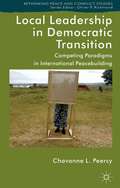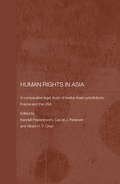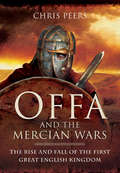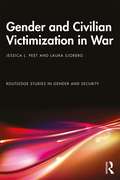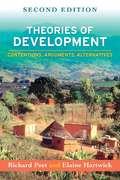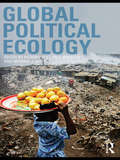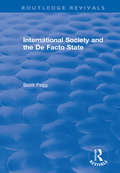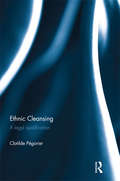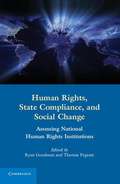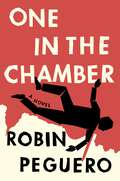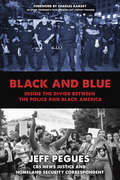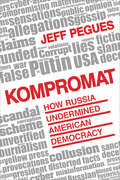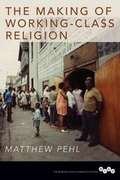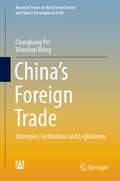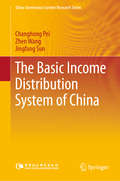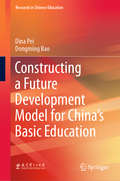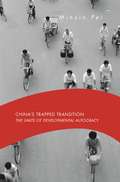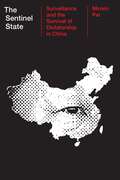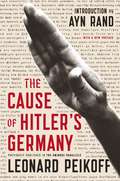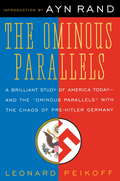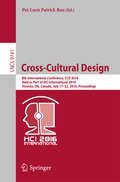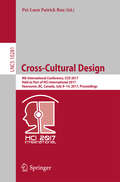- Table View
- List View
Curfewed Night: One Kashmiri Journalist's Frontline Account of Life, Love, and War in His Homeland
by Basharat PeerBasharat Peer's powerful memoir about growing up in war-torn Kashmir.
Local Leadership in Democratic Transition
by Chavanne L. PeercySince the end of the Cold War, the United Nations has become increasingly involved in peacebuilding. However, the often questionable results have led to much mistrust of the methods employed by international organizations. The current transition paradigm assumes that local leaders which participate in the process will assist in the democratic transition and are themselves an output of the process. This assumption appears to be fundamentally wrong. This book examines whether the inclusion of non-democratic leadership in post-conflict transition induces democratic principles and sustainable peace, or if it in fact undermines the values which the international community attempts to promote and contribute towards the solidification of non-democratic regimes. Using an in-depth analysis of local leadership before, during and after democratic transition in three key case studies, namely Burundi, Cambodia and Liberia, the author provides a unique insight into the type of leadership required for transitioning a country to democracy. Delivering a new framework that assists scholars, policymakers and practitioners in understanding the roles of local leaders in democratic transition, it also includes recommendations for future peacebuilding operations.
Human Rights in Asia: A Comparative Legal Study of Twelve Asian Jurisdictions, France and the USA (Routledge Law in Asia #Vol. 2)
by Randall Peerenboom Albert H. Y. Chen Carole J. PetersenHuman Rights in Asia considers how human rights are viewed and implemented in Asia. It covers not just civil and political rights, but also social, economic and cultural rights. This study discusses the problems arising from the fact that ideas of human rights have evolved in Western liberal democracies and examines how far such values are compatible with Asian values and applicable in Asian contexts. Core chapters on France and the USA provide a benchmark on how human rights have emerged and how they are applied and implemented in a civil law and a common law jurisdiction. These are then followed by twelve chapters on the major countries of East Asia plus India, each of which follows a common template to consider the context of the legal system in each country, black letter law, legal discussions and debates and key current issues concerning human rights in each jurisdiction.
Offa and the Mercian Wars: The Rise and Fall of the First Great English Kingdom
by Chris PeersIn England in the eighth century, in the midst of the so-called Dark Ages, Offa ruled Mercia, one of the strongest Anglo-Saxon kingdoms. For over 30 years he was the dominant warlord in the territory south of the Humber and the driving force behind the expansion of Mercias power. During that turbulent period he commanded Mercian armies in their struggle against the neighboring kingdoms of Northumbria and Wessex and against the Welsh tribes. Yet the true story of Offas long reign and of the rise and fall of Mercia are little known although this is one of the most intriguing episodes in this little-recorded phase of Englands past. It is Chris Peerss task in this new study to uncover the facts about Offa and the other Mercian kings and to set them in the context of English history before the coming of the Danes.
Gender and Civilian Victimization in War (Routledge Studies in Gender and Security)
by Jessica L. Peet Laura SjobergThis book explores the role of gender in influencing war-fighting actors’ strategies toward the attack or protection of civilians. Traditional narratives suggest that killing civilians intentionally in wars happens infrequently and that the perpetration of civilian targeting is limited to aberrant actors. Recently, scholars have shown that both state and non-state actors target civilians, even while explicitly deferring to the civilian immunity principle. This book fills a gap in the accounts of how civilian targeting happens and shows that these actors are in large part targeting women rather than some gender-neutral understanding of civilians. It presents a history of civilian victimization in wars and conflicts and then lays out a feminist theoretical approach to understanding civilian victimization. It explores the British Blockade of Germany in World War I, the Soviet ‘Rape of Berlin’ in World War II, the Rwandan genocide, and the contemporary conflict in northeast Nigeria. Across these case studies, the authors lay out that gender is key to how war-fighting actors understand both themselves and their opponents and therefore plays a role in shaping strategic and tactical choices. It makes the argument that seeing women in nationalist and war narratives is crucial to understanding when and how civilians come to be targeted in wars, and how that targeting can be reduced. This book will be of much interest to students of critical security, gender studies, war studies, and International Relations in general.
Theories of Development, Second Edition
by Richard Peet Elaine HartwickWidely adopted, this text critically evaluates the leading theories of international economic development, from classical economic and sociological models to Marxist, poststructuralist, and feminist perspectives. No other book provides such comprehensive coverage or links the theories as incisively to contemporary world events and policy debates. Reexamining neoliberal conceptions of economic growth, the authors show what a more just and democratic form of development might look like today. New to This Edition Revised to reflect evolving global economic realities. Updated with the latest concepts and empirical data. Additional chapter on classical and neoclassical economics. Increased coverage of real-world policy issues.
Global Political Ecology
by Richard Peet Paul Robbins Michael WattsThe world is caught in the mesh of a series of environmental crises. So far attempts at resolving the deep basis of these have been superficial and disorganized. Global Political Ecology links the political economy of global capitalism with the political ecology of a series of environmental disasters and failed attempts at environmental policies. This critical volume draws together contributions from twenty-five leading intellectuals in the field. It begins with an introductory chapter that introduces the readers to political ecology and summarizes the books main findings. The following seven sections cover topics on the political ecology of war and the disaster state; fuelling capitalism: energy scarcity and abundance; global governance of health, bodies, and genomics; the contradictions of global food; capital’s marginal product: effluents, waste, and garbage; water as a commodity, a human right, and power; the functions and dysfunctions of the global green economy; political ecology of the global climate, and carbon emissions. This book contains accounts of the main currents of thought in each area that bring the topics completely up-to-date. The individual chapters contain a theoretical introduction linking in with the main themes of political ecology, as well as empirical information and case material. Global Political Ecology serves as a valuable reference for students interested in political ecology, environmental justice, and geography.
International Society and the De Facto State (Routledge Revivals)
by Scott PeggOriginally published in 1998, International Society and the De Facto Society explores the phenomenon of de facto statehood in contemporary international relations. The de facto state is almost the inverse of what Robert Jackson has termed the ‘quasi-state’. The quasi-state has an ambassador, a flag, and a seat at the United Nations, but it does not function positively as a viable governing entity. Its limitations though, do not detract from sovereign legitimacy. The de facto state, on the other hand, lacks legitimacy yet effectively controls a given territorial area and provides governmental services to a specific population. The book engages in a birth, life, and death or evolution examination of the de facto state.
In Sight of America: Photography and the Development of U. S. Immigration Policy
by Anna Pegler-GordonThis work is the first to take a comprehensive look at the history of immigration policy in the United States through the prism of visual culture. Anna Pegler-Gordon considers the role and uses of visual documentation at Angel Island for Chinese immigrants, at Ellis Island for European immigrants, and on the U.S.-Mexico border.
Ethnic Cleansing: A Legal Qualification
by Clotilde PegorierThis book confronts the problem of the legal uncertainty surrounding the definition and classification of ethnic cleansing, exploring whether the use of the term ethnic cleansing constitutes a valuable contribution to legal understanding and praxis. The premise underlying this book is that acts of ethnic cleansing are, first and foremost, a criminal issue and must therefore be precisely placed within the context of the international law order. In particular, it addresses the question of the specificity of the act and its relation to existing categories of international crime, exploring the relationship between ethnic cleansing and genocide, but also extending to war crimes and crimes against humanity. The book goes on to show how the current understanding of ethnic cleansing singularly fails to provide an efficient instrument for identification, and argues that the act, in having its own distinctive characteristics, conditions and exigencies, ought to be granted its own classification as a specific independent crime. Ethnic Cleansing: A Legal Qualification, will be of particular interest to students and scholars of International Law and Political Science.
Human Rights, State Compliance, and Social Change
by Thomas Pegram Ryan GoodmanNational Human Rights Institutions (NHRIs) - human rights commissions and ombudsmen - have gained recognition as a possible missing link in the transmission and implementation of international human rights norms at the domestic level. They are also increasingly accepted as important participants in global and regional forums where international norms are produced. By collecting innovative work from experts spanning international law, political science, sociology and human rights practice, this book critically examines the significance of this relatively new class of organizations. It focuses, in particular, on the prospects of these institutions to effectuate state compliance and social change. Consideration is given to the role of NHRIs in delegitimizing - though sometimes legitimizing - governments' poor human rights records and in mobilizing - though sometimes demobilizing - civil society actors. The volume underscores the broader implications of such cross-cutting research for scholarship and practice in the fields of human rights and global affairs in general.
One In The Chamber: A Novel
by Robin PegueroOn Capitol Hill, they work you to death. Cameron Leann is new to Washington, D.C. An Iowa farm boy without a penny to his name, Cam has joined a group of affluent junior staffers working for a powerful cohort of U.S. Senators known as The Gang of Six. Liz Frost, the group&’s charismatic leader, teases and strings Cam along as he grows increasingly infatuated with her. Heir to a political dynasty, Randy Lancaster pushes Cam to his limits with his penchant for booze, drugs, and meaningless flings. Charlie James, Liz&’s linebacker boyfriend, keeps Cam at a distance, eyeing the newcomer with suspicion. All of them have one thing in common. They hate their bosses. As the Gang of Six takes up the rushed nomination of the first Black chief justice to the Supreme Court, Cam and his friends are plotting against them. But in the game of politics, one&’s motivations are never as they seem—especially true for Cam, the enigmatic figure at the center of it all. When a bombshell revelation threatens to sink the President's Supreme Court pick, the Gang of Six fractures, pitting senator against senator in a confirmation battle for the ages. Alliances shift with the wind. Everyone is lying to everyone. And on Election Night, one senator will end up dead.
Black and Blue: Inside the Divide between the Police and Black America
by Jeff PeguesThe recent killings in Dallas, Baton Rouge, Ferguson, and elsewhere are just the latest examples of the longstanding rift between law enforcement and people of color. In this revealing journey to the heart of a growing crisis, CBS News Justice and Homeland Security Correspondent Jeff Pegues provides unbiased facts, statistics, and perspectives from both sides of the community-police divide. Pegues has rare access to top law enforcement officials throughout the country, including FBI Director James Comey and police chiefs in major cities. He has also interviewed police union leaders, community activists, and others at the heart of this crisis--people on both sides who are trying to push American law enforcement in a new direction. How do police officers perceive the people of color who live in high-crime areas? How are they viewed by the communities that they police? Pegues explores these questions and more through interviews not only with police chiefs, but also officers on the ground, both black and white. In addition, he goes to the front lines of the debate as crime spikes in some of the nation's major cities. What he found will surprise you as police give a candid look at how their jobs have changed and become more dangerous.Turning to possible solutions, the author summarizes the best recommendations from police chiefs, politicians, and activists. Readers will not only be informed but learn what they can do about tensions with police in their communities.From the Hardcover edition.
Kompromat: How Russia Undermined American Democracy
by Jeff PeguesA timely and essential book from the CBS correspondent who has led their coverage of Russia election interference and the FBI counterintelligence investigation into whether the Trump Campaign coordinated with the Russians.In this compelling account of how the Russians hacked the 2016 election, CBS News Justice and Homeland Security Correspondent Jeff Pegues reveals how far the Kremlin poked into voter databases and why it happened. He also investigates the steps taken to shore up election systems in states across the country ahead of the 2018 midterm and indeed the 2020 Presidential election. Based on exclusive interviews with officials from the FBI, Department of Homeland Security, and cybersecurity experts, Pegues takes readers behind the scenes and into the minds of investigators following the case. He delves into the shadowy world of Russian spies, unraveling the complicated web of contacts between Russian operatives and Trump representatives during the campaign. In one chapter, he focuses on Valeri Gerasimov, widely believed to be the mastermind behind a Russian cyber strategy designed to influence and disrupt democracies. Evidence is presented showing that the Russians infiltrated not only Democratic Party computer networks in the US, but networks in the Ukraine and Europe as well. Consulting with representatives of top cyber security firms, the author discusses what states are doing to protect voting systems in the next midterm elections and beyond. Fascinating and chilling at the same time, Kompromat opens a window into the murky world of espionage, digital warfare, and a newly aggressive Russia brazenly inserting itself into U.S. politics.
The Making of Working-Class Religion
by Matthew PehlReligion has played a protean role in the lives of America's workers. In this innovative volume, Matthew Pehl focuses on Detroit to examine the religious consciousness constructed by the city's working-class Catholics, African American Protestants, and southern-born white evangelicals and Pentecostals between 1910 and 1969. Pehl embarks on an integrative view of working-class faith that ranges across boundaries of class, race, denomination, and time. As he shows, workers in the 1910s and 1920s practiced beliefs characterized by emotional expressiveness, alliance with supernatural forces, and incorporation of mass culture's secular diversions into the sacred. That gave way to the more pragmatic class-conscious religion cultures of the New Deal era and, from the late Thirties on, a quilt of secular working-class cultures that coexisted in competitive, though creative, tension. Finally, Pehl shows how the ideology of race eclipsed class in the 1950s and 1960s, and in so doing replaced the class-conscious with the race-conscious in religious cultures throughout the city.
China’s Foreign Trade: Strategies, Institutions and Legislations (Research Series on the Chinese Dream and China’s Development Path)
by Changhong Pei Wanshan WangThis book is a full review of China's foreign trade in the past 70 years of institutional changes and reform. It presents a magnificent historical overview for China's economic history, sometimes full of trials and hardships, while facing the growth and rise. The author aims to build a unique narrative system to analyze the success and failure, gain and loss during the period, and present the China path in foreign trade among numerous events and different stages under a complex context. It is a must-read book for readers who are interested in China's foreign trade during 1949–2019.
The Basic Income Distribution System of China (China Governance System Research Series)
by Changhong Pei Zhen Wang Jingfang SunThis book aims to explain and explore the distribution mechanism adopted by China, which prioritizes distribution according to performance while taking factors of production into consideration. This mechanism is designed in the context of current market-oriented economy, but it also leads to problems such as the widening income gap among the citizens. Besides serving for economic growth, the authors proposed balancing the interests through policies among different groups as one of the key role for distribution system, which may slow down or even stop the trend of widening income gap. And the authors also provided possible measures for this purpose.
Constructing a Future Development Model for China’s Basic Education (Research in Chinese Education)
by Dina Pei Dongming BaoFocusing on the future development of basic education in China, and on overcoming related issues, this book identifies key breakthroughs, priorities and important fields of basic education reform. In addition, it introduces the “Three Power Model” – decision-making, principals’ leadership, and learning power – to help address the challenges of future development.Unlike much of the research on basic education reform, the book draws on a forward-thinking, realistic and comprehensive project: bringing together 15 universities and research institutes, 16 provincial administration departments, and 100 selected primary and secondary schools, it has also been strongly endorsed by the nation’s leaders. After five years of practice and innovation, it has made significant breakthroughs in many provinces. Sharing unique insights into the project and its outcomes, the book offers an invaluable asset for education researchers, primary and secondary school teachers, and anyone interested in the evolution of basic education in China.
China’s Crony Capitalism
by Minxin PeiChina's efforts to modernize yielded a kleptocracy characterized by corruption, wealth inequality, and social tensions. Rejecting conventional platitudes about the resilience of Party rule, Minxin Pei gathers unambiguous evidence that beneath China's facade of ever-expanding prosperity and power lies a Leninist state in an advanced stage of decay.
China’s Trapped Transition: The Limits of Developmental Autocracy
by Minxin PeiThe rise of China as a great power is one of the most important developments in the twenty-first century. But despite dramatic economic progress, China’s prospects remain uncertain. In a book sure to provoke debate, Minxin Pei examines the sustainability of the Chinese Communist Party’s reform strategy—pursuing pro-market economic policies under one-party rule. Pei casts doubt on three central explanations for why China’s strategy works: sustained economic development will lead to political liberalization and democratization; gradualist economic transition is a strategy superior to the “shock therapy” prescribed for the former Soviet Union; and a neo-authoritarian developmental state is essential to economic take-off. Pei argues that because the Communist Party must retain significant economic control to ensure its political survival, gradualism will ultimately fail. The lack of democratic reforms in China has led to pervasive corruption and a breakdown in political accountability. What has emerged is a decentralized predatory state in which local party bosses have effectively privatized the state’s authority. Collusive corruption is widespread and governance is deteriorating. Instead of evolving toward a full market economy, China is trapped in partial economic and political reforms. Combining powerful insights with empirical research, China’s Trapped Transition offers a provocative assessment of China’s future as a great power.
The Sentinel State: Surveillance and the Survival of Dictatorship in China
by Minxin PeiCountering recent hype around technology, a leading expert argues that the endurance of dictatorship in China owes less to facial recognition AI and GPS tracking than to the human resources of the Leninist surveillance state.For decades China watchers argued that economic liberalization and increasing prosperity would bring democracy to the world’s most populous country. Instead, the Communist Party’s grip on power has only strengthened. Why? The answer, Minxin Pei argues, lies in the effectiveness of the Chinese surveillance state. And the source of that effectiveness is not just advanced technology like facial recognition AI and mobile phone tracking. These are important, but what matters more is China’s vast, labor-intensive infrastructure of domestic spying.Central government data on Chinese surveillance is confidential, so Pei turned to local reports, police gazettes, leaked documents, and interviews with exiled dissidents to provide a detailed look at the evolution, organization, and tactics of the surveillance state. Following the 1989 Tiananmen uprising, the Chinese Communist Party invested immense resources in a coercive apparatus operated by a relatively small number of secret police officers capable of mobilizing millions of citizen informants to spy on those suspected of disloyalty. The CCP’s Leninist bureaucratic structure—whereby officials and party activists penetrate every sector of society and the economy, from universities and village committees to delivery companies, telecommunication firms, and Tibetan monasteries—ensures that Beijing’s eyes and ears are truly everywhere.While today’s system is far more robust than that of years past, it is modeled after mass surveillance implemented under Mao Zedong and Chinese emperors centuries ago. Rigorously empirical and rich in historical insight, The Sentinel State is a singular contribution to our knowledge about coercion in the Chinese state and, more generally, the survival strategies of authoritarian regimes.
The Cause of Hitler's Germany
by Leonard Peikoff"A truly revolutionary idea.... Clear, tight, disciplined, beautifully structured, and brilliantly reasoned." --Ayn Rand Self-sacrifice, Oriental mysticism, racial "truth," the public good, doing one's duty--these are among the seductive catchphrases that circulated in pre-Nazi Germany. Objectivist author and philosopher Leonard Peikoff was Ayn Rand's long-time associate. In The Cause of Hitler's Germany--previously published in The Ominous Parallels--Peikoff demonstrates how unreason and collectivism led the seemingly civilized German society to become a Nazi regime.
Ominous Parallels: The End Of Freedom In America
by Leonard PeikoffAyn Rand chose Leonard Peikoff to be her successor as the spokesman for Objectivism. And in this brilliantly reasoned, thought-provoking work we learn why, as he demonstrates how far America has been detoured from its original path and led down the same road that Germany followed to Nazism. Self-sacrifice, Oriental mysticism, racial "truth," the public good, doing one's duty--these are among the seductive catch-phrases that Leonard Peikoff dissects, examining the kind of philosophy they symbolize, the type of thinking that lured Germany to its doom and that he says is now prevalent in the United States. Here is a frightening look at where America may be heading, a clarion call for all who are concerned about preserving our right to individual freedom.
Cross-Cultural Design: 8th International Conference, CCD 2016, Held as Part of HCI International 2016, Toronto, ON, Canada, July 17-22, 2016, Proceedings (Lecture Notes in Computer Science #9741)
by Pei-Luen Patrick RauWith the increase of globalization of business and industry, IT products and services are often produced and marketed across geographical cultural boundaries without adequate consideration of culture. There is a high probability that IT products and services developed in one country may not be effectively used in another country, which may hinder their market penetration, sales, and use. Based on research and practice, Cross-Cultural Design for IT Products and Servicesprovides a resource for human factors engineers, designers, and marketing professionals who define and develop IT products and services for the global market. With its extensive review of cross-cultural theory and cross-cultural design literature, it is also a resource for those who are interested in research on cross-cultural design. The book presents an overview of the dimensions of culture that have implications for human information processing and affective response. It examines a set of user interface design guidelines grouped into five areas: language, use of color, icons and images, navigation, and information architecture. Also, it addresses physical ergonomics and anthropometry issues. The text translates theory and guidelines into a practical methodology and discusses how to integrate methods of cross-cultural design into a standard engineering process for product development. The authors review and reappraise theories, models, principles, and techniques for design of IT products and services that will be marketed globally. They provide guidelines for user interface design across North American, Asian, and other cultures. Applying the guidelines within the methodological framework provided will enhance the usability and effectiveness of the IT product or service, and contribute to greater user satisfaction, increased productivity, higher sales, and lower product support costs.
Cross-Cultural Design: 9th International Conference, CCD 2017, Held as Part of HCI International 2017, Vancouver, BC, Canada, July 9-14, 2017, Proceedings (Lecture Notes in Computer Science #10281)
by Pei-Luen Patrick RauWith the increase of globalization of business and industry, IT products and services are often produced and marketed across geographical cultural boundaries without adequate consideration of culture. There is a high probability that IT products and services developed in one country may not be effectively used in another country, which may hinder their market penetration, sales, and use. Based on research and practice, Cross-Cultural Design for IT Products and Services provides a resource for human factors engineers, designers, and marketing professionals who define and develop IT products and services for the global market. With its extensive review of cross-cultural theory and cross-cultural design literature, it is also a resource for those who are interested in research on cross-cultural design. The book presents an overview of the dimensions of culture that have implications for human information processing and affective response. It examines a set of user interface design guidelines grouped into five areas: language, use of color, icons and images, navigation, and information architecture. Also, it addresses physical ergonomics and anthropometry issues. The text translates theory and guidelines into a practical methodology and discusses how to integrate methods of cross-cultural design into a standard engineering process for product development. The authors review and reappraise theories, models, principles, and techniques for design of IT products and services that will be marketed globally. They provide guidelines for user interface design across North American, Asian, and other cultures. Applying the guidelines within the methodological framework provided will enhance the usability and effectiveness of the IT product or service, and contribute to greater user satisfaction, increased productivity, higher sales, and lower product support costs.

